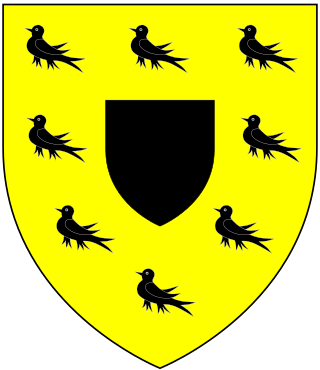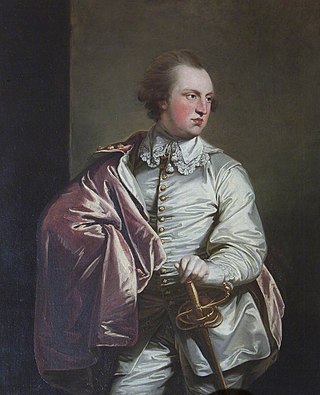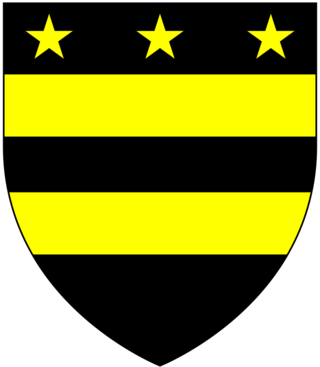

Sir Richard Brownlow, 2nd Baronet (died 1668) of Humby in Lincolnshire, was a landowner. [1]


Sir Richard Brownlow, 2nd Baronet (died 1668) of Humby in Lincolnshire, was a landowner. [1]
He was the son and heir of Sir William Brownlow, 1st Baronet (c. 1595–1666) of Humby, younger brother of Sir John Brownlow, 1st Baronet (c. 1594–1679) of Belton, who died childless when his baronetcy became extinct. His mother was Elizabeth Duncombe, daughter of William Duncombe. [2]
He married Elizabeth Freke, a daughter of John Freke of Stretton in Dorset, [3] by whom he had children: [4]

Baron Stafford, referring to the town of Stafford, is a title that has been created several times in the Peerage of England. In the 14th century, the barons of the first creation were made earls. Those of the fifth creation, in the 17th century, became first viscounts and then earls. Since 1913, the title has been held by the Fitzherbert family.

Baron Brownlow, of Belton in the County of Lincoln, is a title in the Peerage of Great Britain. It was created in 1776 for Sir Brownlow Cust, 4th Baronet. The Cust family descends from Richard Cust (1622–1700) of The Black Friars, Stamford, who represented Lincolnshire and Stamford in Parliament. In 1677 he was created a baronet, "of Stamford in the County of Lincoln". He was succeeded by his grandson Richard Cust, 2nd Baronet, who married Anne Brownlow, daughter of Sir William Brownlow, 4th Baronet, "of Humby", Lincolnshire, and sister and sole heiress of John Brownlow, 1st Viscount Tyrconnel, 5th Baronet of Belton House, Lincolnshire. The 2nd Baronet's son Sir John Cust, 3rd Baronet, sat as a Member of Parliament for Grantham and served as Speaker of the House of Commons from 1761 to 1770 and in 1754 inherited the Brownlow estates, including Belton, on the death of his childless maternal uncle Viscount Tyrconnel. His son Brownlow Cust, 4th Baronet, represented Ilchester, Somerset, and Grantham in Parliament and in 1776 was raised to the peerage as Baron Brownlow, "of Belton in the County of Lincoln", chiefly in recognition of his father's services. He was succeeded by his son John Cust, 2nd Baron Brownlow, who had sat as a Member of Parliament for Clitheroe, Lancashire, and also served as Lord Lieutenant of Lincolnshire for many years. In 1815 he was created Viscount Alford, "in the County of Lincoln", and Earl Brownlow, both in the Peerage of the United Kingdom. In 1810 the future 1st Earl had married Sophia Hume, a daughter of Sir Abraham Hume, 2nd Baronet, of Wormleybury, by his wife Lady Amelia Egerton, a great-granddaughter of John Egerton, 3rd Earl of Bridgewater.
There have been ten baronetcies created for persons with the surname Browne, six in the Baronetage of Great Britain, three in the Baronetage of Ireland and one in the Baronetage of Nova Scotia. Only one creation is extant as of 2010. Three of the creations were for members of the Browne family headed by the Viscount Montagu.

Viscount Tyrconnel was a title in the Peerage of Ireland. It was created in 1718 for Sir John Brownlow, 5th Baronet, Member of Parliament for Grantham and Lincolnshire. He was made Baron Charleville, in the County of Cork, at the same time, also in the Peerage of Ireland. The Brownlow Baronetcy, of Humby in the County of Lincolnshire, was created in the Baronetage of England on 27 July 1641 for William Brownlow. His grandson, the third Baronet, represented Grantham in Parliament. The latter had no surviving male issue and was succeeded by his younger brother, the fourth Baronet. He sat as Member of Parliament for Peterborough and Bishop's Castle. He was succeeded by his son, the aforementioned fifth Baronet, who was elevated to the Peerage of Ireland as Viscount Tyrconnel. The three titles became extinct on Lord Tyrconnel's death in 1754. The Brownlow estates were passed on to the late Viscount's nephew, Sir John Cust, 3rd Baronet, whose son was created Baron Brownlow in 1776.

There have been two baronetcies created for members of the Brownlow family, both in the Baronetage of England. Both titles are now extinct.

Brownlow Cust, 1st Baron Brownlow, of Belton House near Grantham in Lincolnshire, was a British Tory Member of Parliament.

Sir John Cust, 3rd Baronet PC, of Belton House near Grantham in Lincolnshire, was a British politician who served as Speaker of the House of Commons from 1761 to 1770.

John Brownlow, 1st Viscount Tyrconnel, KB, known as Sir John Brownlow, 5th Baronet, from 1701 to 1718, of Belton House near Grantham in Lincolnshire, was a British politician who sat in the House of Commons from 1713 to 1741.

Sir William Brownlow, 4th Baronet was an English politician.

Sir John Brownlow, 3rd Baronet of Belton House near Grantham in Lincolnshire, was an English member of parliament. He built the grand mansion of Belton House, which survives today.

Sir William Brownlow, 1st Baronet of Humby in Lincolnshire, was an English politician and barrister.
There have been four baronetcies created for people with the surname Lee, all extinct.

There have been two baronetcies created for persons with the surname Yelverton, both in the Baronetage of England.
Sir William Williams, 6th Baronet of Faenol (Vaynol) was a Welsh politician and landowner elected as MP for Caernarvonshire from 1689 until his death.

Sir Richard Farington, 1st Baronet was an English Whig politician who sat in the English House of Commons between 1681 and 1701 and in the British House of Commons between 1708 and 1719.

Sir John Redmond Freke, 3rd Baronet was a baronet in the Baronetage of Great Britain and a member of parliament in the Irish House of Commons.

Sir William Carew, 5th Baronet was a British politician who sat in the House of Commons from 1711 to 1744.
Sir Robert Pollock, 1st Baronet, of Pollok, was a British Army officer and Scottish politician who sat in the Parliament of Scotland from 1700 to 1707 and in the British House of Commons from 1707 to 1722.

Richard Brownlow (1553–1638) of Belton in Lincolnshire, was a lawyer who served as Chief Prothonotary of the Court of Common Pleas.

Sir John Brownlow, 1st Baronet of Belton, near Grantham in Lincolnshire, was twice Sheriff of Lincolnshire and on 26 July 1641 was created a baronet "of Belton in the County of Lincoln". He died without progeny when his baronetcy became extinct. His monument survives in St Peter and St Paul's Church, Belton, showing half statues of himself and his wife finely sculpted in white marble.